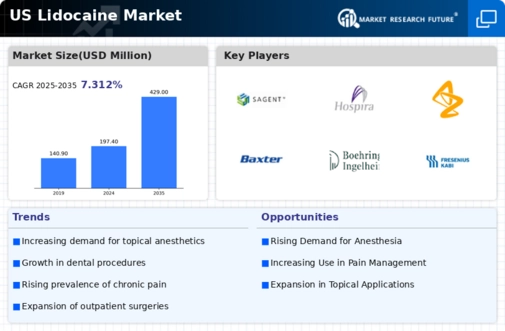Growth in Surgical Procedures
The lidocaine market is positively influenced by the growth in surgical procedures across various medical specialties. As the US healthcare system evolves, the number of surgical interventions, including outpatient surgeries, is on the rise. In 2023, it was reported that over 50 million surgical procedures were performed in the US, with a significant portion requiring local anesthesia. Lidocaine is frequently utilized for its rapid onset and effectiveness in providing localized anesthesia, making it a staple in surgical settings. This trend is expected to continue, as advancements in minimally invasive techniques further increase the volume of surgeries. The demand for lidocaine in these contexts not only enhances patient comfort but also supports the overall growth of the lidocaine market, as healthcare providers seek reliable anesthetic options.
Rising Awareness of Anesthetic Options
The lidocaine market is benefiting from a growing awareness among healthcare professionals and patients regarding the various anesthetic options available. Educational initiatives and training programs have been instrumental in informing practitioners about the efficacy and safety of lidocaine for various applications, including dental procedures and minor surgeries. This increased knowledge is likely to lead to a higher adoption rate of lidocaine, as practitioners recognize its advantages over other anesthetics. Furthermore, patient awareness campaigns are encouraging individuals to inquire about lidocaine as a viable option for pain management. As a result, the lidocaine market is poised for growth, driven by informed decision-making among both healthcare providers and patients, ultimately enhancing the overall landscape of pain management solutions.
Regulatory Support for Anesthetic Products
The lidocaine market is positively impacted by regulatory support for anesthetic products in the US. Regulatory bodies, such as the FDA, are actively working to streamline the approval processes for new formulations and delivery methods of lidocaine. This supportive regulatory environment encourages innovation and the introduction of novel lidocaine-based products into the market. As a result, manufacturers are more likely to invest in research and development, leading to a wider array of options for healthcare providers and patients. The emphasis on safety and efficacy in regulatory guidelines further enhances the credibility of lidocaine products, fostering trust among practitioners. Consequently, this regulatory support is expected to drive growth in the lidocaine market, as new and improved products become available to meet the evolving needs of pain management.
Increasing Prevalence of Chronic Pain Conditions
The lidocaine market is experiencing growth due to the rising prevalence of chronic pain conditions in the US. Conditions such as arthritis, neuropathy, and fibromyalgia are becoming more common, leading to an increased demand for effective pain management solutions. According to recent estimates, approximately 20% of adults in the US suffer from chronic pain, which significantly drives the need for lidocaine-based products. This trend is likely to continue as the population ages and the incidence of chronic diseases rises. Consequently, healthcare providers are increasingly turning to lidocaine as a preferred option for localized pain relief, thereby bolstering the lidocaine market. The focus on improving patient quality of life further emphasizes the importance of effective pain management strategies, positioning lidocaine as a critical component in therapeutic regimens.
Technological Innovations in Drug Delivery Systems
The lidocaine market is experiencing a transformation due to technological innovations in drug delivery systems. Advances in formulation technologies, such as transdermal patches and injectable gels, are enhancing the efficacy and convenience of lidocaine administration. These innovations allow for more controlled and sustained release of the anesthetic, improving patient outcomes and satisfaction. In recent years, the market has seen a shift towards these advanced delivery methods, which are becoming increasingly popular among healthcare providers. As these technologies continue to evolve, they are likely to expand the applications of lidocaine, thereby driving growth in the lidocaine market. The integration of technology in drug delivery not only enhances the therapeutic potential of lidocaine but also aligns with the broader trend of personalized medicine.






















Leave a Comment